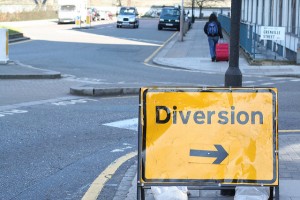
Is prison the right environment for those with severe mental health issues? Evidence indicates that increasingly people with mental health problems are finding themselves incarcerated (Bradley, 2009). There is a growing consensus that this may not be the best environment for those with mental illness, with custody exacerbating issues, and increasing risk of self-harm and suicide (Bradley, 2009).
Issues relating to mental health and the police service have oft been discussed in the woodland. Today’s post is focussed on the costs related to the interaction between NHS mental health services and the police service for those with enduring mental health issues.
Recent years have seen a number of policy recommendations to improve the pathways and interactions between mental health services and the criminal justice system. The most notable of these was the Bradley Report (Bradley, 2009), which featured a series of recommendations to improve and enhance care pathways to improve ‘diversion’. Diversion in this context refers to services that function at the juncture between the criminal justice system and mental health services. The purpose of diversion is to identify and divert those with mental health issues towards the treatment and care they require, particularly as an alternative to prison (Sainsbury Centre for Mental Health, 2009) with the benefit of reducing further exacerbation of mental health issues.
Little is known about the costs associated with the current pathways between mental health services and the police service for those suffering from mental health conditions, and even less is known about the cost of implementing enhanced care pathways as suggested within policy documents.
The enhanced service pathways considered within this paper include:
- Street triage
- A custody link worker
- Mental Health Act (MHA) assessments for all MHA section 136 detainees. Section 136 of the MHA allows the police to take individuals to a place of safety if they are in a public place and they suspect the individual of having a mental illness.
The purpose of this study can broadly be split into two parts:
- Mapping and costing existing service pathways
- Decision modelling to estimate the cost of introducing service enhancements.

How much do diversionary services cost?
Methods
Mapping and costing existing pathways
To map current pathways between existing services, a case-linkage approach was adopted. Data was obtained from an existing study (Lea et al, 2015). Individuals were identified retrospectively and followed up using police and mental health case records for one year. This data came from a rural county in England. To examine the interaction between mental health services and the police service, it was necessary to focus on individuals who had both, i) a record of police interaction, and, ii) known mental health issues.
To achieve this, a sample of cases were randomly selected from cases where individuals:
- Had a record on the neighbourhood harm register, or, were recorded on the National Strategy for Police Information Systems (NSPIS) as having interacted with the police in the second quarter of 2011.
- Had a record from any time period on the RiO (electronic patient record) system with the local mental health trust.
Services were mapped using an iterative case-linkage process. This used the case reports to identify a range of resources and services used by the individuals. Resources included:
- Mental health care services;
- Police and other emergency services;
- Custody services;
- ‘Other’ services e.g. transport.
To calculate the costs of existing pathways, unit costs were attached to the resource use information identified within the case-linkage study. This allowed the calculation of total costs per client from both the mental health care perspective and the police service perspective for the one-year period. Due to the complexity of the pathways, only the most significant cost drivers were included within the analysis. Costs of the current pathways were reported as means, and predictors of costs were identified using bootstrap OLS (ordinary least squares) regressions.
Modelling the cost of service enhancements
At the time of the study, there were no enhanced services within the region, and as such, a modelling approach was required to estimate costs of enhancements. Decision models provide a transparent and logical way of assessing the impact of a change. In this case they were used to model the impact of introducing the enhanced service pathways. The data from the existing pathway formed the basis for the decision model of the enhanced pathways. Models were validated through a variety of external stakeholders including mental health professionals and senior police officers.
Using the case-linkage data, the existing pathways were modelled. To examine the impact of service enhancements, the models were adjusted to reflect the impact of potential enhancements. The three service enhancements that were modelled included:
- Street triage – this involves a mental health nurse attending incidents with officers when there is a suspicion that mental health support is required with the intention of diverting individuals appropriately. The addition of street triage should divert individuals away from unnecessary Section 136 detentions. The case-linkage study suggested 14% of clients needed a section 136. A pilot study of street triage suggested that just 3.2% of clients actually need to go to a section 136 custody suite when street triage is operationalised. Consequently, within the street triage model, there was a conservative 50% reduction in the probability of being referred to a section 136 custody suite following street triage.
- MHA assessments for all individuals detained under section 136 of the MHA. From the case-linkage data, it transpired that not all section 136 detainees were receiving an MHA assessment (according to the MHA (1983), this should be compulsory). The authors therefore examined the impact of all section 136 detainees receiving the MHA assessment. The modelled impact of this was the reduction in likelihood of detention, and the removal of the need for forensic medical examiners.
- A link worker within custody suites. This enhancement covered the introduction of a link worker for those currently within custody on an arrest. Within this model, probabilities remained the same as in the base case.
Results
The cost of existing pathways
Resource use data was collected for 55 out of the 80 individuals within the case-linkage study. All individuals had at least one contact with mental health services in the 1-year period following the first contact with police.
Mental health care costs
- The mean mental healthcare cost per person was £10,812 (95% CI £6,055 to £19,726)
- The biggest driver of mental healthcare costs was inpatient services which accounted for 76% of costs
- Only 13 of the 55 clients had an inpatient stay, these stays were however typically long in duration with a mean inpatient stay of 90 days (range: 5 to 310 days). Thus, a minority appear to account for the majority of mental healthcare costs in this context.
Police service costs
- The mean costs associated with the police service use was £4,552 (CI £3,551 to £6,058)
- The largest cost drivers in relation to police service costs was the attendance at incidents which accounted for 59% of the total police costs
- The average number of police contacts was 7, of which 59% required at least one police officer in attendance. On average 3 police officers attended each incidence
- 13% of the contacts required time in custody
- When custody was required, the mean time spent was 8 hours and 38 minutes. Of those who went into custody, 12% required MHA assessments.
Total costs
- The total cost to both mental health services and police was £15,364 (95% CI £10,689 to £24,960) per person
- When considered on a per incident basis, the average cost per incident within the current care pathway was estimated to be £522 per incident
- The only baseline characteristic found to be associated with cost was whether the client was a non-substantive referral, that is, if they had been on the case load of a care team for less than two months at the time of the police contact
- Those who had not been on care team’s case load for more than two months costed an additional £12,850 (95% CI £2,945 to £29,192) per person.
The cost of implementing enhanced pathways
Street triage
The cost of implementing street triage increased the cost per incident from £522 to £526. A number of sensitivity analyses were conducted suggesting this value is moderately sensitive to changes. For example, a sensitivity analysis suggested that if street triage reduced the numbers detained for a section 136 MHA assessment to the degree found in the pilot study (3.2%) then costs per incident would fall to £478 per incident.
MHA assessments for all section 136 detainees
Again, there was an identical increase in cost as street triage, with costs rising to £526 per incident.
Link worker at custody suites
The introduction of a link worker again increased costs, this time by 2% to £534 per incident. A sensitivity analysis examined the impact of increasing client contact from one hour to three hours, this led to an increase in cost per incident to £557.

Service enhancements were associated with a small increase in costs per incident.
Discussion
It is estimated that the cost of the current pathway was £522 per incident, of which 70% fell on mental health services, and 30% on police services. The introduction of enhanced pathways has little impact on the costs as estimated through the modelling process. Each enhancement under the base-case assumptions were associated with a small increase in cost. The authors note that this small increase per incident could have substantial budgetary impacts if scaled up. In short, the results suggest that there would be small increases in costs per incident due to enhancing service pathways, which could be large when extrapolated. On an individual basis however, these cost increases were relatively minor and did not increase substantially under sensitivity analysis. It is however important to be cautious in terms of generalisability due to a number of limitations: A relatively small sample size in a rural population, and only the short term (1 year) main cost drivers were included.
Having read the paper, the first thing that strikes me as a health economist is, ‘What about the outcomes?’ This article for good reasons has focussed on costs, and makes a good attempt at modelling the costs of service enhancements whilst also recognising significant limitations and assumptions. In relation to outcomes however, it simply acknowledges that there may be parallel benefits to the clients and society of enhanced pathways.
The government reports which suggest service enhancements, do not make these suggestions to reduce costs, they make these suggestions to improve the long term outcomes of those with mental health conditions. It is presumed that the point of the enhanced service pathways is to divert patients with mental health needs towards the care they require. The end result of this process should be fewer mental health patients in inappropriate prison settings, improved mental health, and a reduction in self-harm and suicide (Bradley, 2009). Without any information in relation to outcomes, it is difficult to draw any conclusions around the cost-effectiveness of the service enhancements. Having said that, given minimal increase in individual level costs, any improvement in terms of health-related quality of life would likely be deemed cost-effective.
This study provides a starting point by mapping current resource use and identifying the cost of service enhancements. The next step should be to measure the long term costs and benefits (to both the client, and society) of such enhancements. Once this data has been collected it may then be possible to make firmer decisions regarding the cost-effectiveness of these polices.

The study didn’t consider any outcomes or improvements in quality of life resulting from diversion.
Summary
- The cost per incident without enhancing service pathways is approximately £522
- Service pathways enhancements as advocated in government and policy reports are associated with a very small increase in cost per incident
- Evidence on the impact of service enhancements on outcomes is required
- Future research should focus on examining the impact of diversionary services on outcomes for clients with mental health issues and conducting a full economic evaluation.
Links
Primary paper
Heslin M, Callaghan L, Barrett B, Lea S, Eick S, Morgan J, Bolt M, Thornicroft G, Rose D, Healey A, Patel A. (2016) Costs of the police service and mental healthcare pathways experienced by individuals with enduring mental health needs (PDF). Br J Psychiatry. 2016 Mar 17.
Other references
Bradley K. (2009) The Bradley Report: Lord Bradley’s Review of People with mental Health Problems or Learning Disabilities in the Criminal Justice System. 2009.
Sainsbury Centre for Mental Health. (2009) Diversion: A better way for criminal justice and mental health. London; 2009.
Lea S, Callaghan L, Eick S, Heslin M, Morgan J, Bolt M, et al. (2015) The management of individuals with enduring moderate to severe mental health needs: a participatory evaluation of client journeys and the interface of mental health services with the criminal justice system in Cornwall. Heal Serv Deliv Res. 2015 Apr;3(15):1–232.

Costs of the police service and mental health care pathways https://t.co/xN1vLpjXbb via @sharethis
Costs of the police service and mental health care pathways https://t.co/VoUx1Lgb11 #MentalHealth https://t.co/1bgOwriBCu
@Mental_Elf great stuff @captain_canaway & agree need to know what the real benefits are by measuring outcomes that matter to the individual
@ian_hamilton_ @Mental_Elf Thanks Ian – much appreciated.
@captain_canaway @Mental_Elf my pleasure, hope to see some more health economic blogs, you’re an endangred species !
@ian_hamilton_ @Mental_Elf I’m getting moved onto at least two more MH projects so fingers crossed there’s more to come!
@captain_canaway @Mental_Elf would be grateful if you could let me know when you have some output from, just in case I miss it !
“@Mental_Elf: Costs of the police service and mental health care pathways https://t.co/03fMyA8fYw” @MentalHealthCop
@DrG_NHS @CrisisConcordat & by happy coincidence covered in todays @Mental_Elf https://t.co/Wx3wXsPwOd
Today @captain_canaway reviews a new study that maps & costs pathways through mental health & police services https://t.co/m8M753D9di
Costs of the #police service and #mentalhealth care pathways https://t.co/DR9cYtQubi
Interesting, but an incomplete picture without factoring in admission/length of stay costs
@MargaretHeslin1 Hi Margaret – FYI – I’ve blogiefied your recent paper for Mental Elf https://t.co/K1OZ3snL4B
@timkendall1 @DrSNThomas @helencrimlisk @DrG_NHS @felly500 Coincidentally – I blogified this for @Mental_Elf today! https://t.co/ucgE4INFDX
Costs of the police service and mental health care pathways https://t.co/HlpxmT7sCk
Completely agree with the point on outcomes! The outcomes for people experiencing the services are incredibly important. We would have loved to investigate this but just don’t have the data to do so, yet.
Hi Margaret – the ‘yet’ at the end of your comment is very promising!…any time scales on when you’re likely to have some outcomes data?
Unfortunately not. We really, REALLY want to look at outcomes but don’t have anyway to do this at the moment. Trying to develop grants to do this at the moment but slow process so results are far off.
Key policy recs to mental health-police blog: https://t.co/nnETdwxiZU https://t.co/7mCGjAMrVO @captain_canaway @Mental_Elf
Enhanced criminal justice pathways with mental health care may have little cost impact, but what about outcomes? https://t.co/7wxtIuL7ea
Costs of police service & mental healthcare pathways experienced by individuals with enduring mental health needs https://t.co/m8M753D9di
Street triage, custody link workers & MHA assessments. All in our blog about police & mental health pathways https://t.co/m8M753D9di
@Mental_Elf Peer research study on police and mental health crisis response here. Also mentions ST: https://t.co/ePOebfRutq
@DrEm_79 @Mental_Elf thanks it’s really valuable work
@samistigger @Mental_Elf all down to the participants who were amazingly honest and open and generous with their time explaining experiences
@Mental_Elf @DrEM_79 Have to be frank: there is an *awful* lot in this to disagree with from various assumptions, misconceptions to facts.
@Mental_Elf @DrEm_79 I’d take exception to the concept of ‘unnecessary’ s136; and there’s is no strict *requirement* for MHA ax after s136.
@MentalHealthCop @Mental_Elf @DrEm_79 https://t.co/5Ll2HlFQmZ
@Mental_Elf @DrEm_79 It starts on basis that street triage incidents are all jobs the police were dealing with anyway (wrong) and that >>
@Mental_Elf @DrEm_79 << all street triage schemes are modelled in the same way (they’re not). The data to on policing / MH is *really* bad!
Key policy recs to mental health-police blog: https://t.co/nnETdwxiZU https://t.co/7mCGjAMrVO @captain_canaway @Mental_Elf @rcpsych
ICYMI, my post for @Mental_Elf – costs associated with mental health & police interactions https://t.co/K1OZ3s69G1 https://t.co/lrfC7nCWLn
How much do diversionary services cost? Read about police & mental health service enhancements https://t.co/m8M753D9di
Don’t miss: Costs of the police service and mental health care pathways https://t.co/m8M753D9di #EBP
RT @mgoat73: Costs of the police service and mental health care pathways https://t.co/OWInShM6VI via @thementalelf
Costs of the police service and mental health care pathways https://t.co/cr9pNoJMeZ
[…] May had been involved in two issues that have been examined in previous blogs – the use of police cells when people are detained under section 136 MHA and the number of prisoners with mental health problems. The police and other professionals who are […]